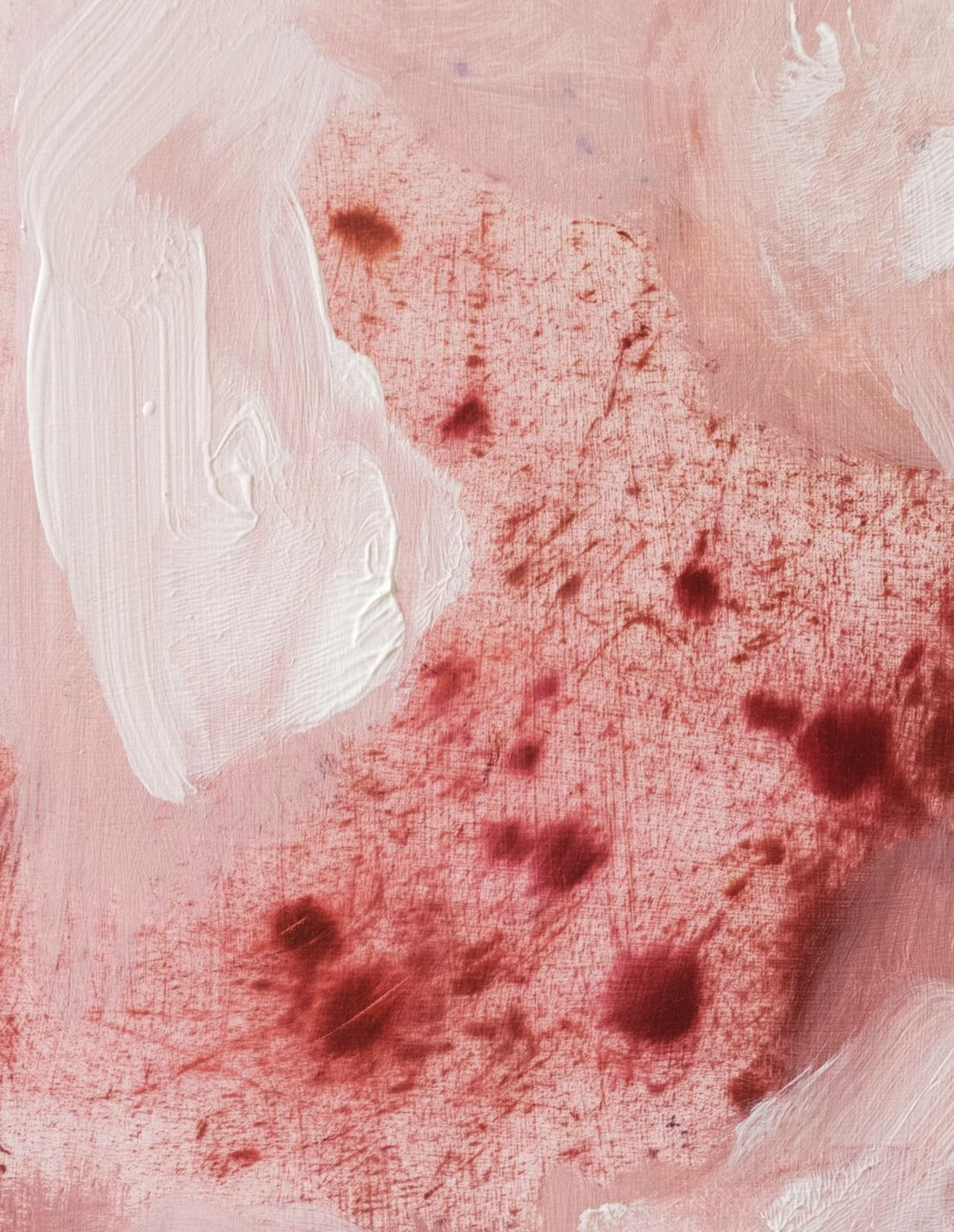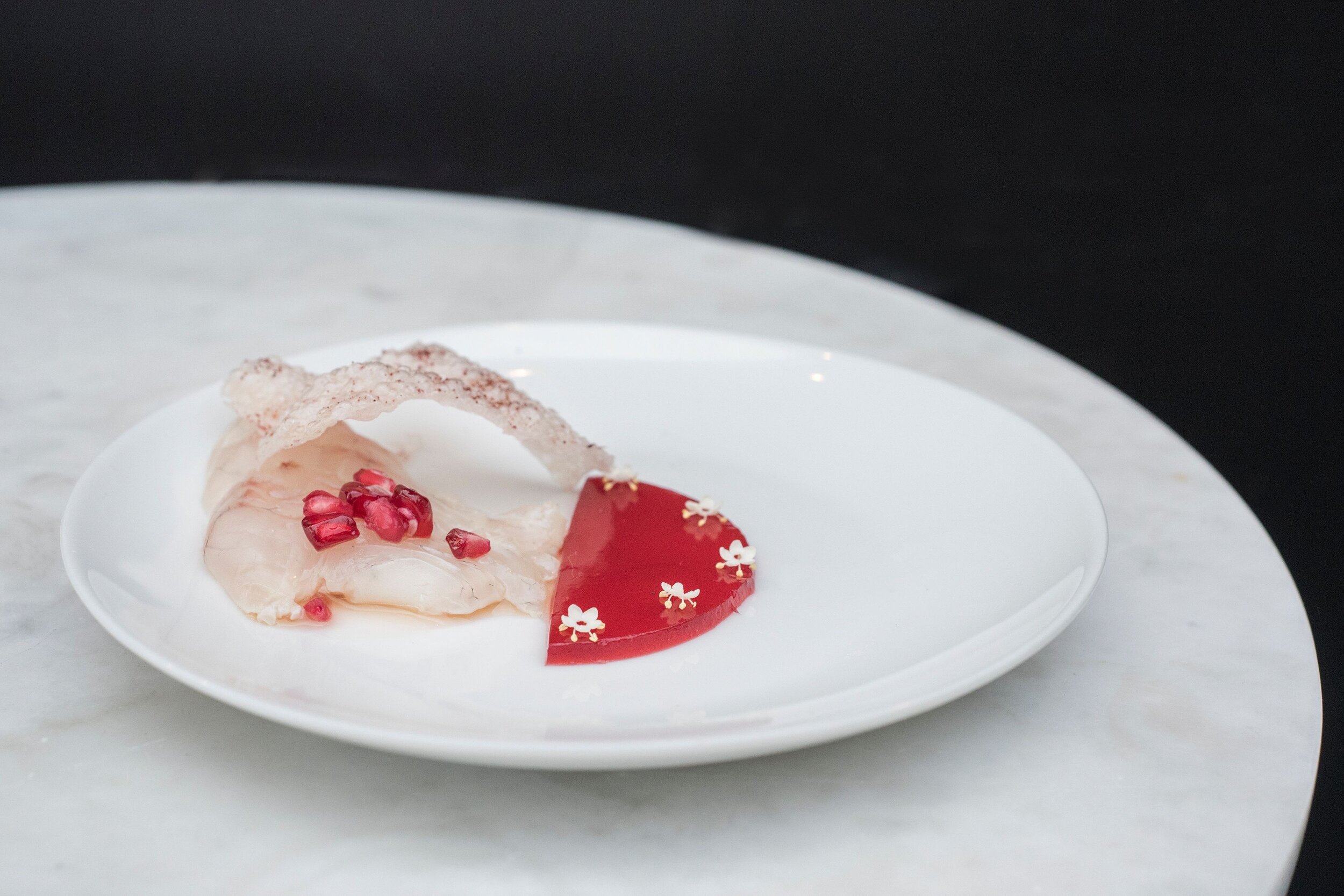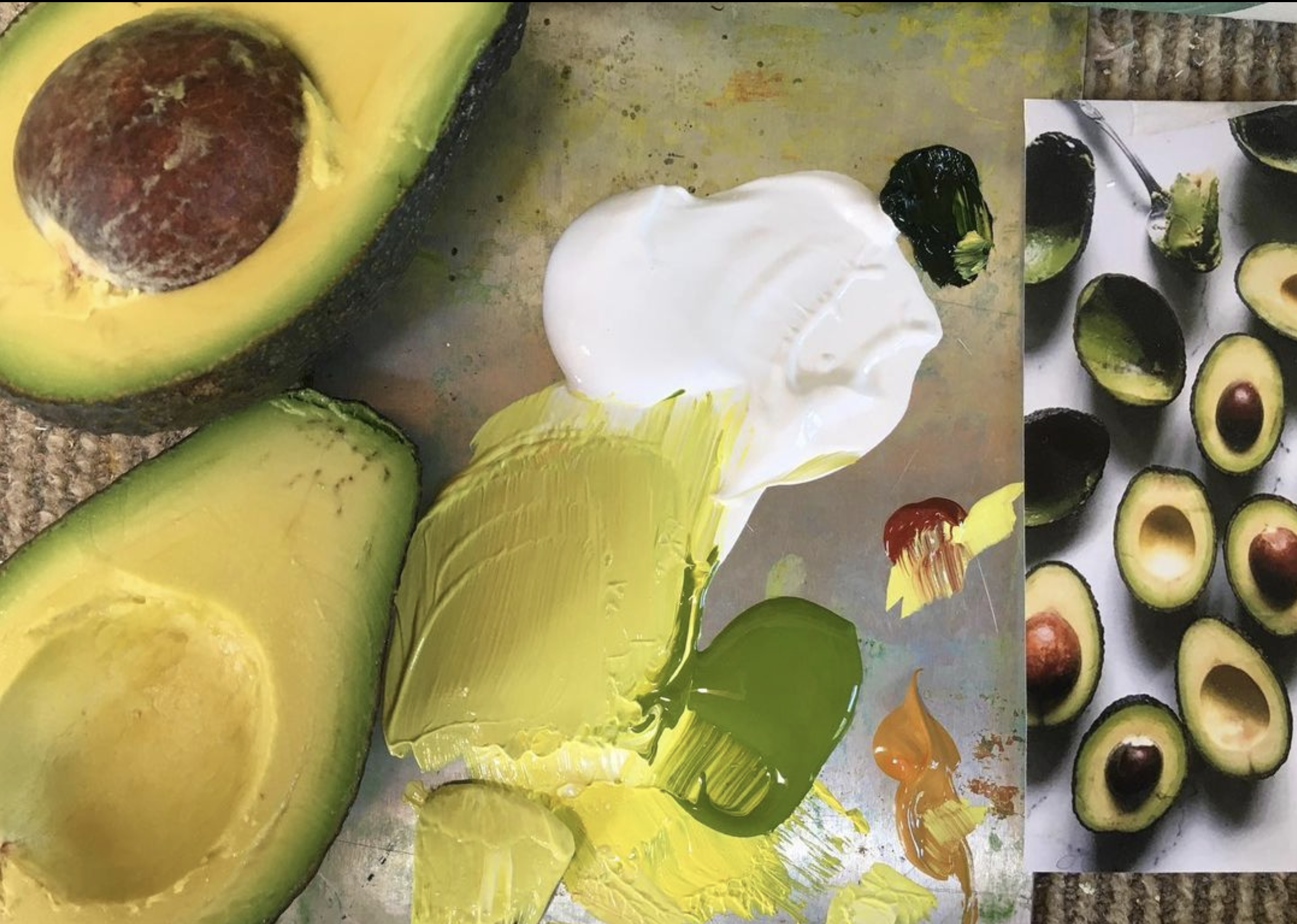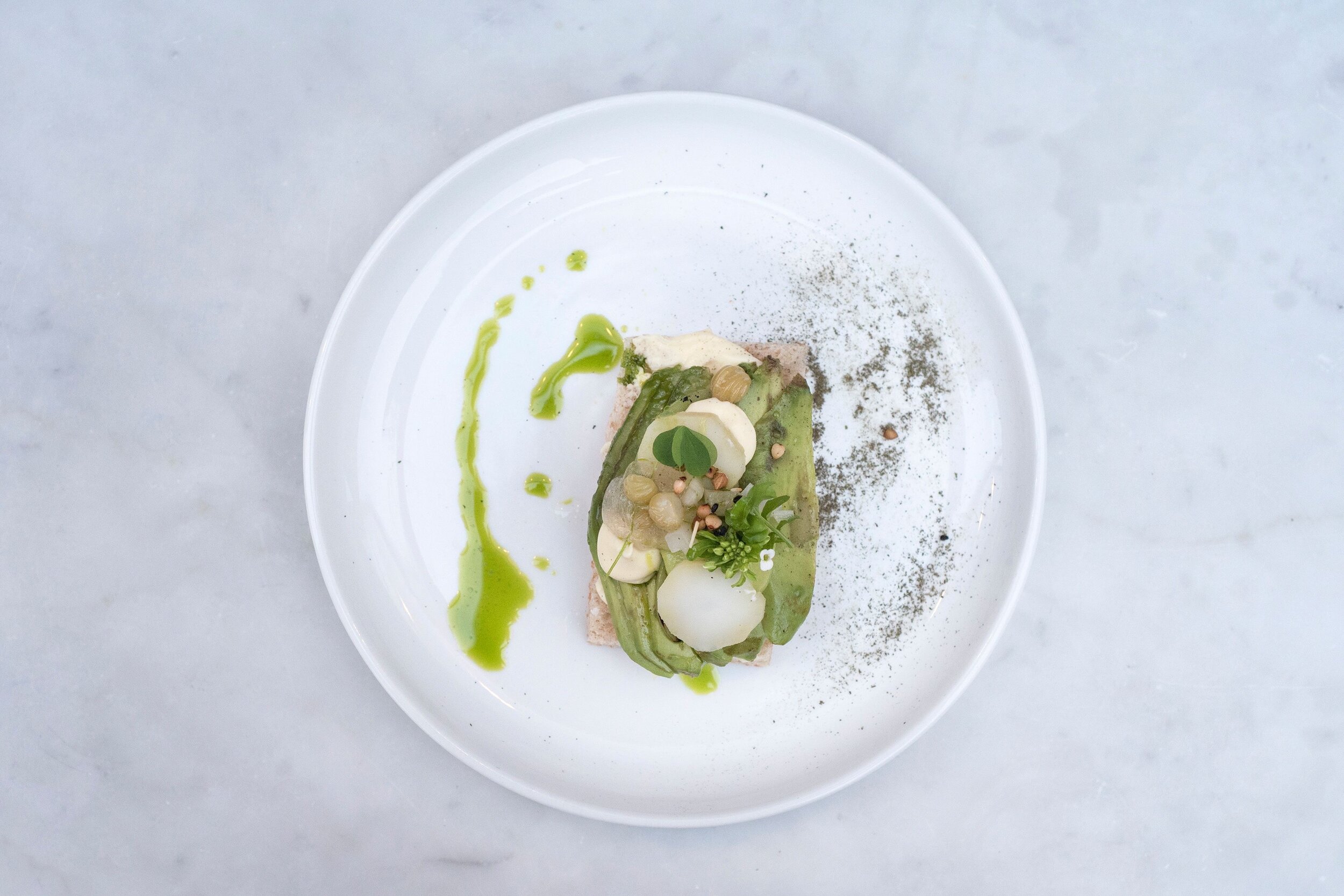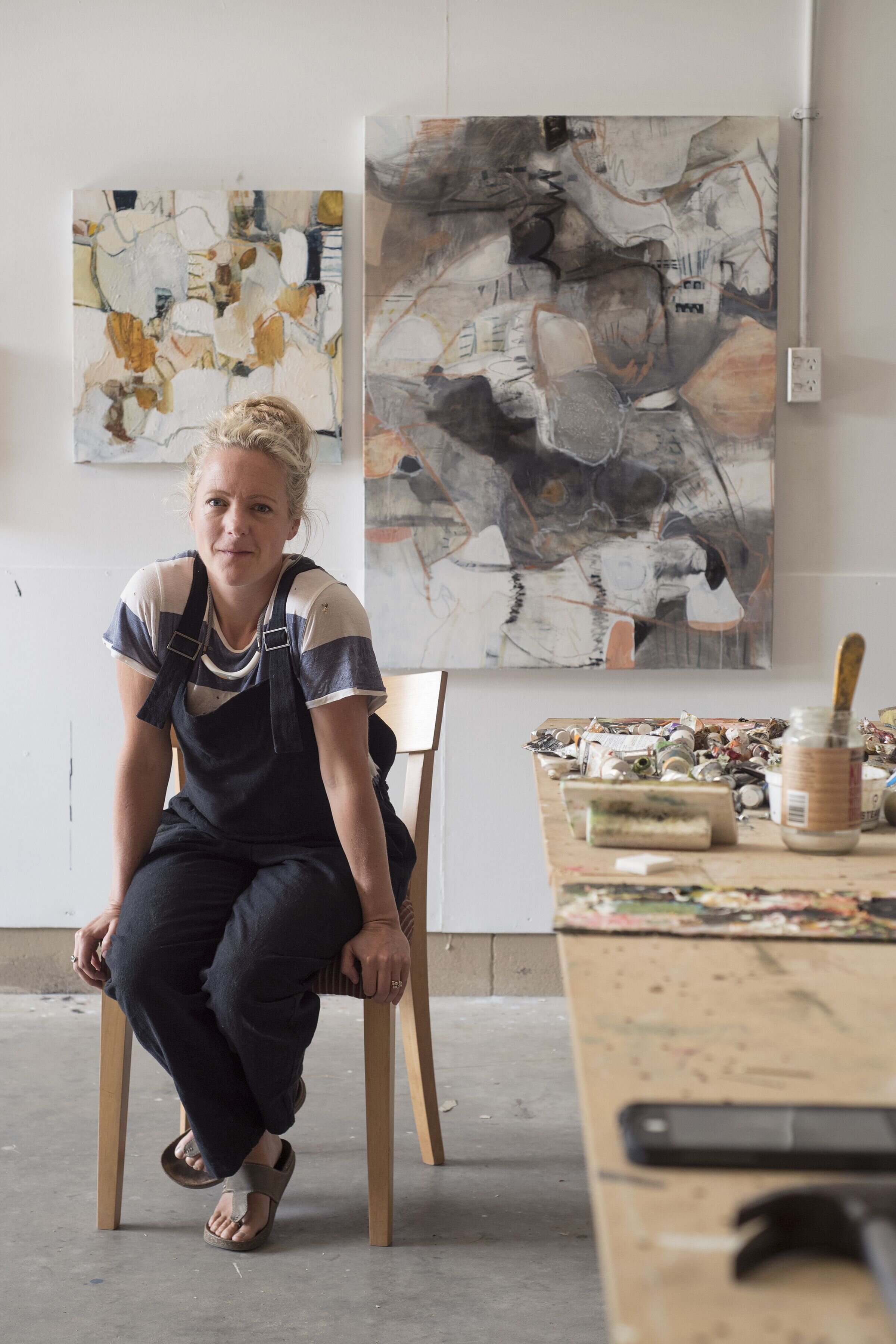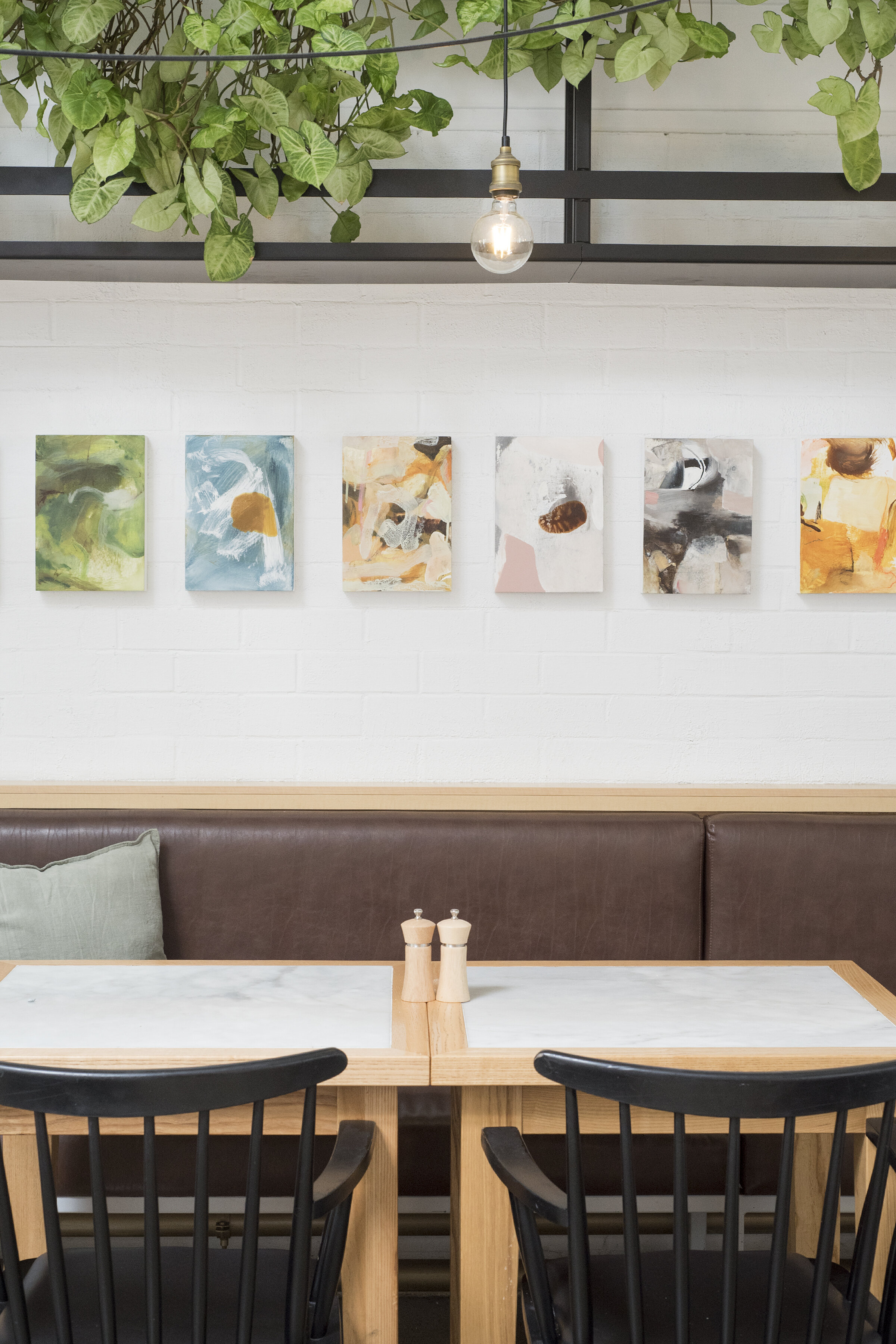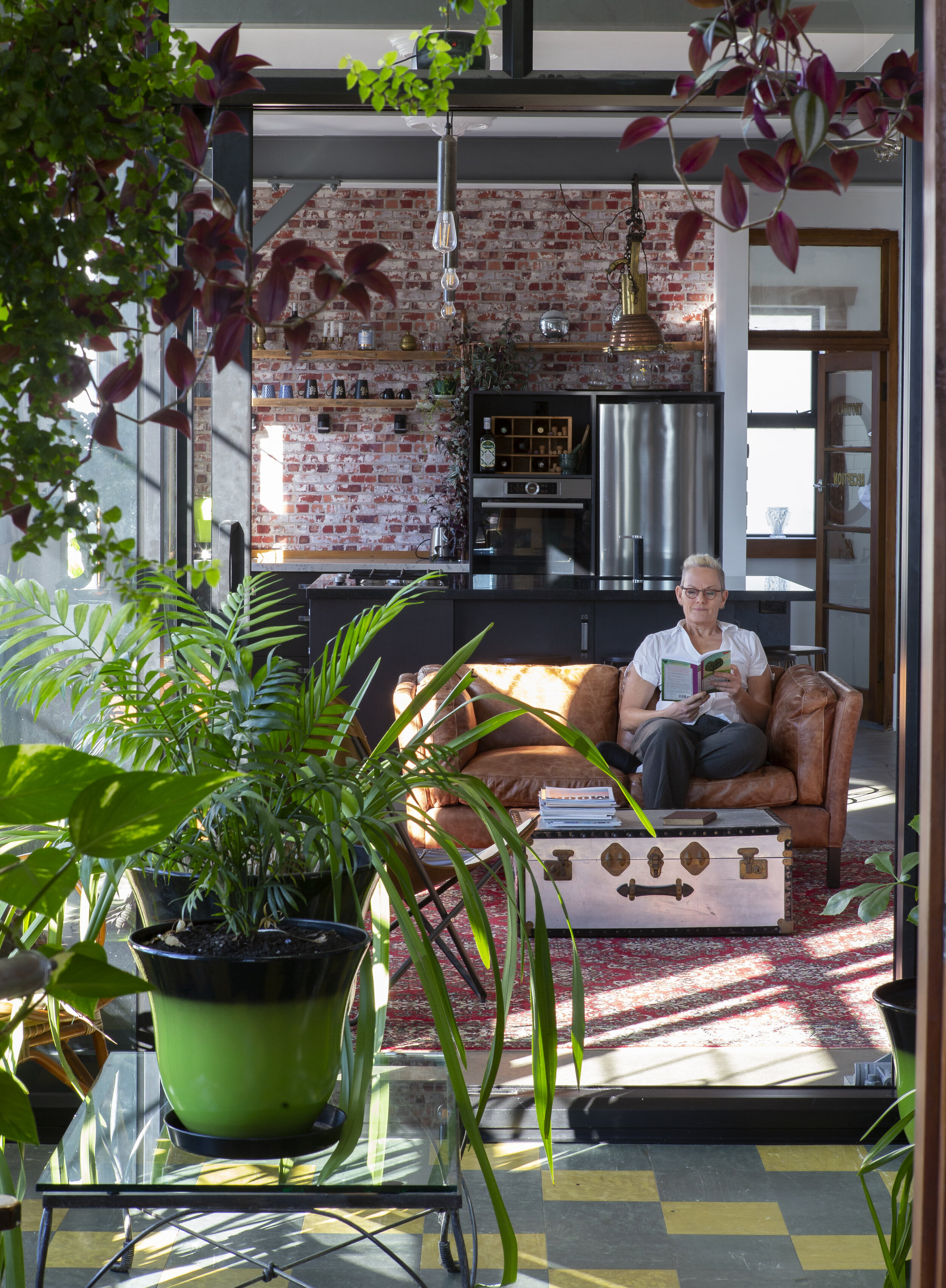Something to talk about
At Sala Art Gallery, the art is an invitation to conversation and connection.
At Sala Art Gallery, the art is an invitation to conversation and connection.
words KARL PUSCHMANN
photos JAHL MARSHALL
The thinking behind Tauranga’s newest art gallery can be described as gently radical. There are no price tags or pretension on exhibits at Sala Gallery. Instead, it takes a more holistic approach where the art on display can be considered an invitation to deep thought, reflection and, most importantly, genuine connection.
“I put the gallery together as an excuse to have conversations with people,” Nigel Banks says. “Rather than a focus on showing art or a focus on selling pictures, the focus of the gallery is about having conversations with visitors about the origins of meaning in their lives. The primary purpose of the pictures is as props to support those conversations.”
Nigel is both Sala’s founder and the artist behind its inaugural exhibition We Are The Earth. This series of works meditates on the journey of life and explores larger themes of sense and self. Nigel sees the work as a conduit to conversation, either with oneself or with the artist himself, as he is often to be found nearby.
“It’s been a lifelong obsession, thinking about issues of meaning and where meaning comes from,” Nigel says. “When you touch into those moments, it’s something that feels really worthwhile. Much more so than just the standard social exchange.”
The vibe inside Sala is peaceful and meditative, which is appropriate as it’s nestled beside the popular Thai Touch massage therapy studio in Tauranga’s CBD, which Nigel opened with his wife Orasa in 2023. In fact, there’s an internal entrance to the gallery straight from Thai Touch which allows those holistic vibes, and visitors to the gallery, to flow in. It’s a welcoming space and one that takes off any pressure or intimidation that people can sometimes feel about entering a gallery.
That’s one of the most important aspects of value that I see in the philosophy that’s driving this,” Nigel explains. “Instead of going into a gallery and feeling an obligation to look into the pictures and figure out what they’re about, in this case the whole conversation is about meaning, and the pictures are there to support that conversation. You’re not looking for the meaning in the picture, the pictures are there to support the conversation about the meaning. It takes the pressure off.”
This core belief shapes every aspect of Nigel’s work and Sala, right down to the gallery’s carefully selected name.
“It’s a Thai word, chosen because it’s soft, because it’s short, it’s got a slight repetition in it, but also that it means ‘outdoor meeting room’. A sala in Thai is like a pavilion or a little shrine or temple in somebody’s garden. People go to a sala, they meet in the sala, and they'll have conversations that are important to them. This is creating a space that is dedicated to that same sort of purpose.”
While Sala only recently opened its doors, the idea for a gallery of this nature has been percolating in Nigel’s mind for 20 years, after a “transformative” experience at an exhibition by the prominent New Zealand artist Melvin ‘Pat’ Day in Wellington.
“I was totally entranced by his artworks, just amazing stuff. I spent two hours there, intimately and repeatedly engaging with every piece. It was like a mental vacuum cleaner, a little bit like meditation. Extraneous thoughts were washed away from me. When you’ve got art, you’ve got an obvious thing to focus on. By the time you’ve done that for a couple of hours you are left in this blissful state of being totally at peace and at one with the pictures. I was interested in whether this might happen for other people.”
It was his piece ‘Billboard’ that inspired him to make this longheld dream an “audacious” reality. Fittingly, ‘Billboard’ is Sala’s centerpiece. It abstractly depicts the journey of life, the search for meaning and what you leave behind. While working on it he vowed that when finished he’d have a place to hang it. Over the 18 months it took to create ‘Billboard’, he worked on having Sala ready to open.
“When I put this up it felt like a monumental shift inside me,” he says. “It’s like a perfect life opened out in front of me because I get to have these conversations on a semi-professional basis. Having conversations with people about the stuff that is actually really important to everybody, but most of the time we don't talk about, is a really amazing thing to me. Just casually with people who have stopped by, I’ve had amazing conversations about people’s lives and it’s just really, really neat.”
Then the artist smiles and says, “In Sala’s case I’m thinking beyond anybody’s requirement. I don’t think anybody needs this. But I’m hoping that some people will really enjoy it.”
Surf’s up!
One of Tauranga Museum’s first exhibitions will celebrate the region’s pivotal role in Aotearoa’s surfing culture.
One of Tauranga Museum’s first exhibitions will celebrate the region’s pivotal role in Aotearoa’s surfing culture.
words Karl Puschmann
boards Dusty Waddell Collection
Mount Maunganui is world-famous in New Zealand for its rolling surf and golden sands. Each summer people flock to the beaches to hang ten or catch rays. But, outside the surfing community, not a lot of folks know about the region’s rich history and contribution to Aotearoa’s surfing culture.
That’s all about to change. The Tauranga Museum team is hard at work putting together one of the first exhibitions to go on display when the long-awaited new museum opens its doors in 2028.
“The exhibition on surf and beach culture will be one of our earlier exhibitions on display when we open,” museum curator Fiona Kean enthuses.
It will certainly be hard to miss. Following the museum’s acquisition of local surfing icon Dusty Waddell’s legendary surfboard collection, the museum is already preparing 120 surfboards for display. These all hold national significance and physically chart the evolution of surfing in New Zealand.
“There’s shortboards and longboards, and in addition to those there’s boogie boards, belly boards, skim boards… there's probably another 50 of those,” Kean says. “We’ve even got 40 skateboards. We've had to create a special space at our storage facility for it all.”
Through the various shapes and sizes of the surfboards, you’ll see trends come and go as you progress through the years. It will also highlight beach culture with displays of fabulous local swimwear, wetsuits and ephemera like surf posters. We have an amazing hollow board that is over four metres long. It was made at the Mount in 1952 by Ron White and Jock Carson using the famous Tom Blake design. Kean is also in discussions with a local shaper who makes surfboards from – of all things – wool.
“It’s an exciting idea because most surfers are really interested in their environment and in cleaning up and preserving the water they swim in,” Kean says. “Surfboards in the past have been made of foam and more toxic materials, so innovations like that look at how surfing can be more environmentally friendly.”
While we all recognise the region for its good surfing, its epic contributions to the sport aren’t as well known. Surfing and surfboard manufacturing in Tauranga goes all the way back to the early 20th century. Through her research, Kean discovered there were, in fact, two surfboard makers here in the 1930s making, selling and hiring their boards out to summer beachgoers in that era.
Once established here, surfing never left. In the 1940s and ‘50s more shapers arrived and the era of plywood boards began.
“Plywood is an important story for Tauranga,” Kean says. “That takes you down a whole other rabbit warren of the people making hollow surfboards out of plywood. And then you have the leap into foam-core or surfboards made with foam blanks. You've got probably one of the biggest names in surfboard making, a man called Bob Davies, who comes to Tauranga and sets up a factory here, and at the same time another local guy, Ted Davidson, owns a sports shop on Cameron Road and he starts making surfboards out of that shop.
From there, it’s honestly like a wave of shapers and makers around the country flowing in and out of each other’s lives and businesses and the Mount and Tauranga were an important part of that scene.”
It’s fascinating to hear her talk about how huge Tauranga’s impact on New Zealand surfing actually was. It will be even more fascinating to see it. Surfboards are big items, especially the older longboards, which on average stand at a towering 12 feet tall. The scale of the exhibition is going to be awesome.
Kean is excited about the project and can’t wait to share everything being discovered about Tauranga’s rich surfing history when the museum opens.
“We want people to have a greater understanding of surf and beach culture and its significance to where they live. We’re a really important piece of that overall surf culture puzzle. For example, the first surfing nationals were held at Mount Maunganui in 1963,” she says. “The museum hopes to give people a sense of belonging to this place. I’d love for locals to feel pride in our role in the surf industry and to come away with a sense of enjoyment. It will be a fun exhibition but one that does have moments for reflection and moments where you’ll feel challenged.”
For those who simply can’t wait until 2028 to see what’s barreling down the pipeline, Kean reveals how you can get a sneak peek at the surfboards and, essentially, the Bay’s surfing history on Tauranga Museum’s website.
Kean says the exhibition will appeal to non-surfers just as much as those who like to hit the waves, as the experience the museum team is curating showcases not just surfing but wider beach culture.
With a few more years of prep work, research and collaboration with the community before it opens, Kean has a very simple objective for the exhibition in mind.
“We want it to blow people away,” she laughs.
Guiding light
A stunning new interactive artwork, unveiled during Matariki,
has brought its warm glow to a humble bus shelter – and to passersby – in Tauranga.
The Willow Street bus shelter in central Tauranga has a chequered history, but artist Sara Hughes (left) hopes her interactive, colourful art installation, Midnight Sun, will shift the public’s opinion of the troubled site. The artwork launched during Matariki, and its intent is to bring beauty, light and a feeling of warmth and safety into the city centre during a season of new beginnings.
Suspended above the Willow Street bus shelter and wrapping around Tauranga Art Gallery to Wharf Street, Midnight Sun is comprised of 96 panels of glass which create a 260-square-metre corridor of coloured light on the footpath below. As clouds pass overhead, hues of pink and gold will flicker on the pavement, bathing passers-by in a warm glow. At night, Midnight Sun
will be lit to simulate the luminosity of sunset and bring beauty – and safety – to the bus stop and surrounding area.
Sara, an established and dynamic artist whose works grace public and private spaces across Australasia, tells UNO more about her creative process and what inspired her to create Midnight Sun.
UNO: How did this project come about?
Sara: I was approached by Sonya Korohina of Supercut Projects at the end of 2020. At that time, she was putting forward a proposal to Creative New Zealand to fund a series of public artworks for Tauranga. These projects were originally to coincide with the Tauranga Arts Festival, but due to COVID-19 cancellations, the projects were delayed and have been spread out over the past year, with mine being the final one. I was drawn to this project as I felt an affinity with the city.
UNO: What is your aim with the piece?
Sara: Midnight Sun is an artwork about the daily rhythm of the setting sun. I aim to draw viewers in with beauty and recognition, then allow them to discover the artwork and have their own encounter with it. I hope it will pause people in their daily life. Midnight Sun can be walked under and driven past; it will have different moods in different weather conditions; it can be viewed during the day and at night; it’s open 24 hours a day – there are many ways to experience this artwork.
UNO: What was it like to work on?
Sara: The project has been in development since early 2021. There are a lot of different people required to get this artwork to completion, and it’s been great to work with Sonya and Tauranga City Council on the details and project management. Local photographer Anne Shirley documented sunsets in Tauranga for me over the month of June in 2021. These photographs form the base layers on top of which I layer my painted imagery. While I have been developing the imagery, I work closely on the technique with a printer, and I worked with light designer Richard Bracebridge on achieving a warm golden glow of 2200 kelvin to mimic the light at sunset. It’s exciting to see all the parts come together.
UNO: What inspires you?
Sara: I have travelled a lot and lived all over the world, and these experiences have influenced me. I’m currently fascinated by the measuring of time and light and the way our day is structured by the sun and the earth’s orbit. How the light changes during this rotation from day to night and all the variants in between. Wherever you are in the world you can experience this – that’s what I’m interested in capturing in Midnight Sun.
UNO: What do you love about public art?
Sara: Over the past 20 years, I’ve focussed on working in site-specific contexts and examining the way people relate to art in their environment. I strongly believe public artworks are important to the urban fabric of cities. Aesthetics are important, but public art is more than decoration; it can make an important contribution to a site, it can communicate with the public, and it gives voice to ideas. I love that public art can be seen by everybody. There’s humanity in that. It’s rewarding for me to hear from a wide range of people who respond to seeing my public artwork. People’s lives are busy and its fulfilling when someone tells you that the highlight of their day is the bus trip past your artwork.
Inspired by food, embodied by paint and canvas - a visual feast by Nicola Bennett
Nicola Bennett has made a career out of combining two of her key passions in the most delectable way. Art and food rock the world of this Okere Falls-based artist who produces paintings inspired by her love of food – there’s a deep connection, she says. Colour, to her, is like flavour.
WORDS Monique Balvert-O’Connor PHOTOS Katie Hoy
Nicola Bennett has made a career out of combining two of her key passions in the most delectable way.
Art and food rock the world of this Okere Falls-based artist who produces paintings inspired by her love of food – there’s a deep connection, she says. Colour, to her, is like flavour.
“For me food and art are so intricately linked, in their processes, shared pleasure and transformation.
“I love the sensory pleasure of both preparing ingredients and of applying paint. Whether it’s fashioning fresh food into a meal to be shared or using tubes of paint and a canvas to create a painting that may cause an emotional response… Either way, there is magic in that transformation,” she enthuses.
Nicola says she’s no chef, but it’s often a cooking experience that inspires her work. Her studio is festooned with photos of food and different dishes and lots of recipe books. This way, processes influence each other, she explains. Of great excitement is the pending completion of a kitchen within her studio that’s attached to the house she shares with her husband Stefan, their son Theo (13) and daughter Greer (11).
“When that’s finished, I’ll be able to cook and paint at the same time. Partway through cooking, if I am inspired, I can go straight to painting and then back again.”
This abstract expressionist uses oils and mixed media on her large paintings and also her smaller works, which are A4-size to reference a recipe book. Wooden panelled, they give the feel and weight of a cookbook.
“I love to work this small because it feels intimate and handheld. But I also love to work very big, which results in a different kind of painting: Big, bold and gestural.”
Representational art isn’t Nicola’s gig. She may be inspired by an avocado (she adores them, by the way) but the viewer of her art wouldn’t necessarily know that’s the case.
“My source of inspiration is a flavour, and I want the feeling of that flavour to be in my work in an abstract way. And, of course, the wonderful thing about abstract art is that it can be anything to anyone. Someone may see forests and plants rather than interpreting any actual ingredient, such as avocado,” explains this vegetarian artist with a penchant for green. (If you love food and nature, it’s very hard not to be drawn to green, Nicola says.)
Nicola’s paintbrush is often intimately acquainted with her ingredients – she paints on avocados or aubergines, for example, to ensure she has the exact colour.
“I could even use a big squish of paint to give the feel of smashed avo. Three-dimensional in only small amounts adds to the seductive quality of paint.”
While Nicola enjoys her own company, she gets a real buzz from meeting other creative people.
“I get their energy. I love meeting makers and talking about their passion and creativity.”
Sometimes something truly wonderful grows out of such meetings. Take Nicola’s mutually creative collaboration with Timo Dicker, the executive head chef of Rotorua’s Terrace Kitchen.
In 2019, Terrace Kitchen hosted “Feast,” an event featuring small paintings Nicola had created in response to foraged ingredients such as artichoke, wild garlic and sorrel. Timo created a menu to suit. Over two nights, the creative duo gave floor talks about their processes and inspirations, accompanied by a five-course meal.
In 2020 came “Forage and Feast”, incorporating seven small courses with Nicola and Timo setting each other various challenges. Black-and-white and pink-and-white dishes were the result of a colour competition. Twenty-six of Nicola’s paintings were displayed on the walls (and remained afterwards for a month as an exhibition), referencing ingredients Timo had cooked with for the event. Identifying those ingredients was a talking point for the diners.
Nicola’s keen for more such sharing of the joy and similarities of cooking and painting.
“I experiment with colours that look just right; the chef with ingredients and flavours that taste just right. It’s a similar sensory search for the perfect balance of colour or flavour.”
She’s keen to introduce this collaborative concept in other centres such as Tauranga, Auckland and Wellington.
In the meantime, life at the easel is busy. Nicola’s next commissioned work involves pink oyster mushrooms.
There’s also an award ceremony to attend – Nicola is a Molly Morpeth Canaday Award recipient. Such accolades are especially sweet for the artist, who was dyslexic at school. Her creativity couldn’t be contained, resulting in a Bachelor of Art in the UK and then a Master’s in Fine Art (passed with first class honours) in New Zealand. Until three years ago, she was an art teacher.
And she’s cooking up a storm. She’ll often take prepared food along to share at houses where she’s showcasing her art – usually involving ingredients that have inspired the painting.
How does this artist know exactly when a painting is completed? The answer, of course, references her other love.
“It is finished when it’s ready to eat with the eyes… A visual feast, if you will.”
Creative character: writer and poet Stuart Greenhill and the Fenton Arts Collective
Writer and poet Stuart Greenhill of the Fenton Arts Collective in Stratford talks to UNO.
PHOTOS Andy Jackson and Jane Dove Juneau
UNO: What a beautiful building you are housed in. How did you find it and what was the journey to restoration?
Stuart Greenhill: My partner Jo Stallard was looking for a heritage building to save. In 2016, she offered a ridiculously low amount for the Egmont Chambers building in Stratford, which was earthquake-rated 17%. It was accepted. The building was not listed on Stratford’s District Plan, so no funding was available. Other than that, it was a fantastic journey. We had enough experience from previous projects to ensure the outcome was what we wanted. The renovation won an Architecture Award in 2019 for Renovations and Additions. The building fascinates people, and many come just to see it.
What is the Fenton Arts Collective?
It is a collective of our passions and interests: Art, history, gin and espresso. We are 310 metres up a mountain, so our aspirations are just as high for each of them. The Collective offers people something unique, something intimate, something historical and modern; it offers a genuine experience.
Your partner Jo Stallard is the curator and artist-in-residence. What is Jo's artistic background, and what does she paint?
Jo comes from an art history background and is a portrait artist. She works in the traditional painting technique of “grisaille” or “dead painting” to traverse the landscapes of the human face and body. Looking, seeing and perceiving are the semantics of what a face has to give, share or provoke, and those are the landscapes she loves. So people come to the Collective, grab a coffee or gin from downstairs, and visit Jo’s working studio upstairs -- and maybe even chat about a commission.
Refreshment plays a strong role in your building; we hear gin and espresso coffee flow freely! Tell us more.
To survive in the provinces, businesses require diversity. Coffee, retail, and an art gallery were great, but we needed something more. Making gin is like writing. Botanicals are characters; each brings a different personality, so it was simply a matter of creating fantastic stories. People hear those when they book a gin tasting with me. Our espresso bar uses Proof & Stock coffee, made by our daughter, Adrianna, and offers high-quality healthy options including gluten-free and keto. And Tauranga celebrity Chef Ken Greenhill creates a monthly five-course degustation for us. They are so popular we have a waiting list.
What's your connection to Tauranga?
My brother’s been here since 1997, and Jo and I set up Deckchair on Marine Parade with him in 2007. We sold in 2010, travelled for a bit, and were approached in 2013 to establish Quantum Vis Eatery on Cameron Road. We still have a connection to the Bay, having formed many friendships over those years, and are thrilled that our gin is now carried by Mount Wine Barrel, Maunganui Rd and Fife Lane Restaurant.
And on top of all that, you're a published author! What have you written?
Dante Fog was published by Austin Macauley Publishers in London last year. It is autobiographical fiction (yes, that is a genre). The mother in the novel tells her son, “There are no better observers of life than artists.” I totally agree. Artistic license takes life and makes it art. That’s why I write poetry and prose and make gin and Jo paints. There is a beautiful complexity in discovering and understanding the layers in the mirror looking back at us. Our art attempts to express it so does the character Dante Fog.
What does the future hold for the Fenton Arts Collective?
There’s pressure to grow, but the distillery will remain boutique and so will the Arts Collective. Our gallery is booked for 2021, I am contracted to Austin Macauley Publishers for my next book, and Jo has two exhibitions this year. The future will be busy.
The Incubator
“In 2013, a few of us artists wanted studios, get out of our homes, and be in a space with other artists, and possibly exhibit our work. There was nowhere really in Tauranga for artists and musicians to be together.”
WORDS TALIA WALDEGRAVE PHOTOS TRACIE HEASMAN
After writing about The Men’s Shed in the summer UNO, I convinced my editor to let me go back to The Historic Village, as there’s just so much going on. Last time I came, my interest was piqued by the big red barn of The Incubator.
Simone Anderson gives me a guided tour and explains the role of The Incubator in Tauranga.
“In 2013, a few of us artists wanted studios, get out of our homes, and be in a space with other artists, and possibly exhibit our work. There was nowhere really in Tauranga for artists and musicians to be together.
“We found this brilliant space at The Historic Village, and started looking around at filling the gaps culturally by offering adult art classes, putting on exhibitions and events.
When The Incubator opened in 2013, Simone and the team decided to have an exhibition. “We wanted it to be amazing, and for everyone to feel part of it, even if we thought we might not sell anything! The audience became the art too. We called it The Midnight Circus, and everyone came in costume. We had trapezists, fire eaters, all sorts! We wanted people to really feel enriched by it, that what we had done was worthwhile.”
“The speed with which The Incubator has grown has been completely unforeseen. The growth has been reactionary to the hunger. There was no common denominator for art in our city, just lots of fracture. The Incubator is a platform where that creativity can take place.
“We run lots of projects, supported by a collective made up of our resident artists, and a wider group of creative people who support our philosophy who volunteer a wide range of skills; graphic designers, writers, craftspeople, and theyall collaborate on our projects.”
A Grim Tale
To explain the kinds of projects they undertake, Simone hands me a copy of A Grim Tale. This beautiful book was a collaboration with The Women’s Refuge, putting together survivors of physical abuse, writers and artists. Putting such beauty behind such a taboo subject is such an innovative way to tell a story and just highlights how creatively The Incubator team likes to think.
Other collaborations around the city have The Incubator stamped all over them and one in particular is the colourful pianos we featured in the Peter Williams issue last year. “We were asked to paint one piano, we said we’d do three and we ended up doing eleven.”
A new exhibition space has just gone in and as Simone explains, it’s for emerging artists looking to showcase their work. “It is incredibly difficult to get your work into a gallery, so we wanted to provide something that catered for that.”
Behind the exhibition space are the studios of the resident artists. Wandering between them is like being in an underground cave and each one is completely unique; paintbrushes, tools and inspirational musings are crammed in like organised clutter.
The Artery
Simone leads me into the Artery, the recently acquired building next door that they use for art classes.
“When the government axed night classes in schools, people no longer had anywhere to go. We saw a huge gap to fill that creative space. These are bite sized, achievable classes, often run by our resident artists and the connect people in a social way as well as a creative way. It takes them out of isolation. Most people walk away with connections, having made new friends.”
The classes range from one day to six weeks, and cover printing, painting, ceramics and more. Classes are always changing and information is kept up to date on The Incubator website.
Time to Visit
“The Village comes alive every second Sunday and we wheel out our stage and local musicians perform. It astounds me that aside from the bar and pub scene, there’s nowhere for musicians to meet, so this is another way for us to provide that opportunity.”
Once again I walk away feeling inspired and it’s wonderful to see this space that Simone’s team have created for artists to collaborate.
“It’s not just about the Incubator as a place, it’s what we want to achieve. We want everybody to up the value of arts within the community. Art is not about retail or income, it’s about a way of life.”












